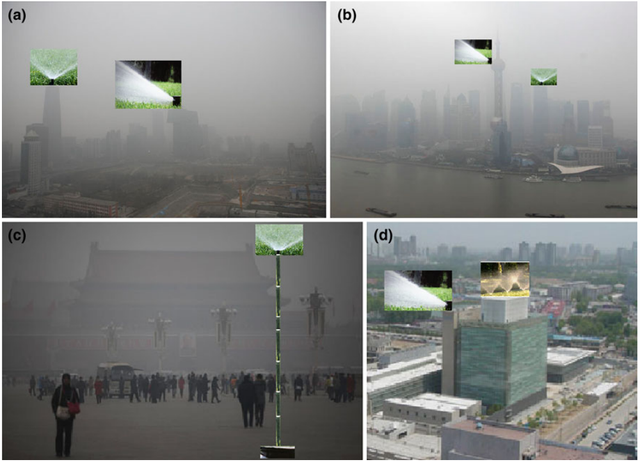China Wants to Wash the Smog Away With Giant Sprinklers From Skyscrapers
2014.01.21
There's nothing not worth trying when it comes to clearing the health hazard smog in China now. It is becoming a major issue, with hospitals opening up "smog clinics" and waves of city dwellers migrating to more rural areas to escape it.
Chinese officials are pursuing "cloud seeding" as a way to control the levels of pollution, but a Zhejiang University professor thinks using huge sprinklers from skyscrapers could be the answer.
Yu Shaocai is a former U.S. Environmental Protection Agency employee and an expert on "wet deposition." The process involves falling raindrops or snowflakes to scavenge aerosol particles from the air. They can collect, and deposit the polluted particles on the ground. It is the same reason why the air looks clearer and cleaner after a heavy shower.
Shaocai proposes to kickstart wet deposition in polluted cities with geoengineered urban infrastructure - attaching giant sprinklers to the exterior of skyscrapers. Then spray water into the atmosphere to clear out toxins and gases.

Beijing on January 16. Image: ChinaFotoPress.
According to the South China Morning Post, one scientist questions where the water would come from and how it would be recycled, but also grudgingly admited that "assuming his team can find a system that works, and they've done enough economic analysis and considered the handling of water resources, this could be a viable option."
It'll be an expensive endeavor, but the cost of not doing it either is worse. Theoretically, it is a sound idea.
Shaocai told the SCMP that he and his students plan to carry out tests at Zhejiang University, first,and then in Hangzhou.
Here are some photoshop composites that show what giant shower heads from skyscrapers would look like:

In December, the China Meteorological Administration announced a $277 billion plan to begin large-scale cloud seeding around Chinese cities, clearing pollution by "firing rockets carrying a payload of silver iodide particles into the clouds." Will that work as well?
[Environmental Chemistry Letters; South China Morning Post]
Chinese officials are pursuing "cloud seeding" as a way to control the levels of pollution, but a Zhejiang University professor thinks using huge sprinklers from skyscrapers could be the answer.
Yu Shaocai is a former U.S. Environmental Protection Agency employee and an expert on "wet deposition." The process involves falling raindrops or snowflakes to scavenge aerosol particles from the air. They can collect, and deposit the polluted particles on the ground. It is the same reason why the air looks clearer and cleaner after a heavy shower.
Shaocai proposes to kickstart wet deposition in polluted cities with geoengineered urban infrastructure - attaching giant sprinklers to the exterior of skyscrapers. Then spray water into the atmosphere to clear out toxins and gases.

Beijing on January 16. Image: ChinaFotoPress.
According to the South China Morning Post, one scientist questions where the water would come from and how it would be recycled, but also grudgingly admited that "assuming his team can find a system that works, and they've done enough economic analysis and considered the handling of water resources, this could be a viable option."
It'll be an expensive endeavor, but the cost of not doing it either is worse. Theoretically, it is a sound idea.
Shaocai told the SCMP that he and his students plan to carry out tests at Zhejiang University, first,and then in Hangzhou.
Here are some photoshop composites that show what giant shower heads from skyscrapers would look like:

In December, the China Meteorological Administration announced a $277 billion plan to begin large-scale cloud seeding around Chinese cities, clearing pollution by "firing rockets carrying a payload of silver iodide particles into the clouds." Will that work as well?
[Environmental Chemistry Letters; South China Morning Post]
More Articles
Copyright © Fooyoh.com All rights reserved.